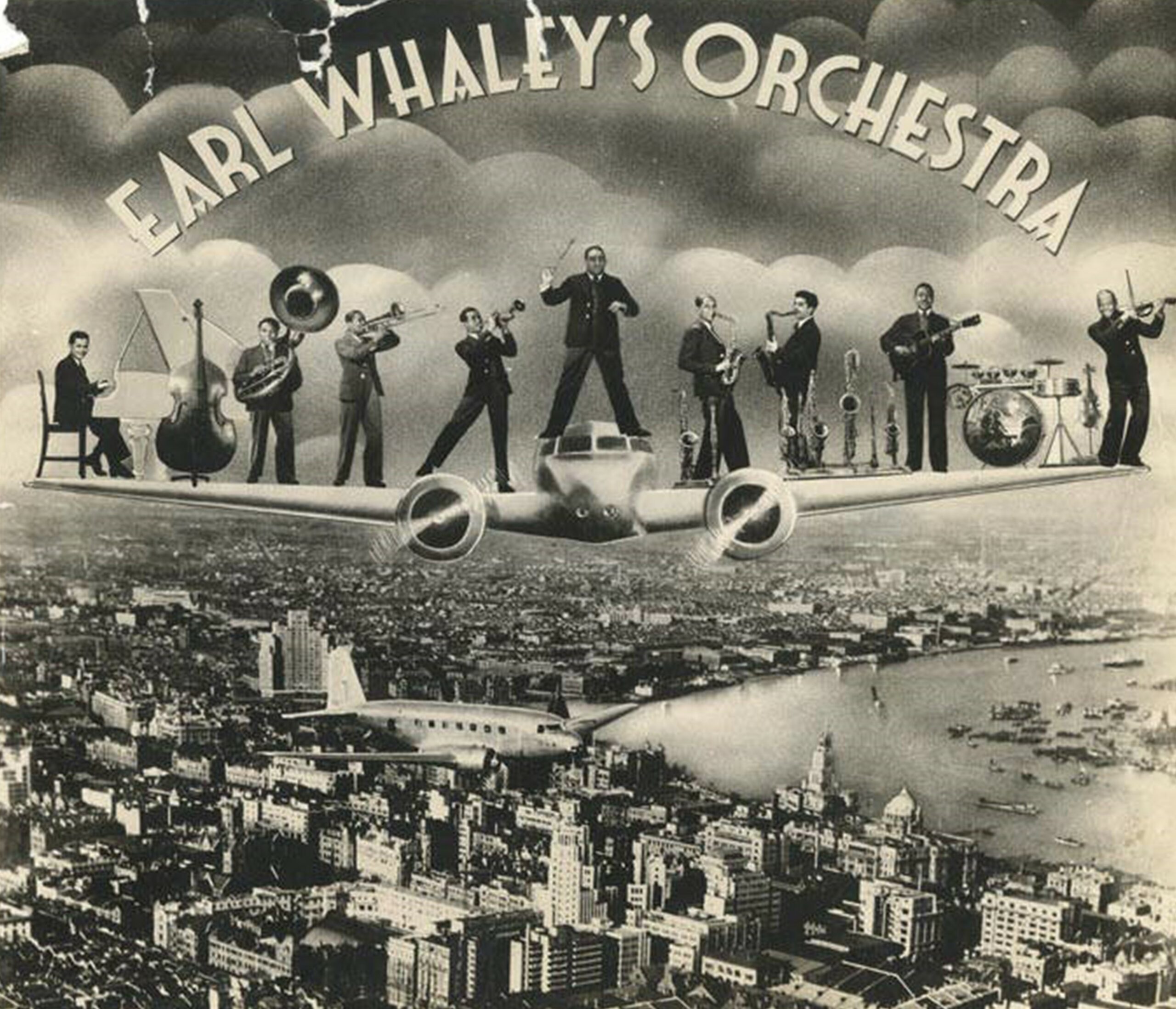In the following article novelist and independent historian Amy Sommers briefly outlines the experience of African Americans in Asia between World Wars I and II. She argues that African American influence in Asia was situated in four broad categories: the performing arts, international relations, faith, and intellectual exchange.
Black Americans venturing overseas during the interwar period are usually presented as fleeing from Jim Crow oppression east to Europe (think Josephine Baker in Paris). Less known are their experiences in crossing the Pacific. African Americans were active in Asia in the 1920s and 1930s and indeed, the strong through-line that emerges from examining their Asia-focused endeavors is their range and ambition. Whether as a means to benefit from their talents or as an avenue to share their gifts, the extent of Black Americans’ agency and success in interwar Asia merits attention.
Depictions in film and elsewhere of Black Jazz Age artists spreading that new artistic form in post-World War I Europe abound. However, a similar dynamic was also unfolding in the Asian Pacific. Indeed, performing artists formed the largest and most visible group of African Americans in Asia during the two decades between the World Wars.
Some artists made a circuit, either around the world with stops in a few Asian cities, or around Asia itself which might include destinations such as Batavia (now Jakarta) in the Dutch East Indies (now Indonesia), Singapore, Calcutta, India, Manila, Philippines, Kobe and Tokyo, Japan, and Shanghai and the then British colony of Hong Kong. Others took up extended residence in a particular city such as musicians Teddy Weatherford in Calcutta, or Bill Hegamin, who arrived in Shanghai in the mid-1920s and went on to make a small fortune performing and operating a studio and music school until interned by the Japanese in 1942. Some combined multiple talents operating as performers, talent scouts, managers, writers, and businessmen while other others focused on performance alone.
The go-go zeitgeist of the 1920s seemed to impel many across the Pacific with the chance to simultaneously experiment and prosper. A decade later, the difficulties of finding work in Depression-era America made the opportunities in Asia all the more attractive. From cities across America performers were recruited: Earl Whaley and his band from Seattle; Teddy Weatherford, a stellar pianist from Chicago; and from Los Angeles, Valaida Snow (whose talent on the trumpet was compared to Louis Armstrong’s, and so impressive that Queen Wilhemina of the Netherlands bestowed upon her a golden trumpet, which the Nazis confiscated in 1941). There was also Buck Clayton and his 14-piece Harlem Gentlemen from the most famous black community in the United States.
Life in Shanghai, the ‘Paris of the Orient,’ was particularly attractive. Pay was good, the cost of living low, and the glamorous, modern hotels, ballrooms and clubs with a vibrant nightlife were all a big draw. In his memoir, Buck Clayton vividly describes the delights of delicious cuisine, custom-tailored wardrobes, regular horseback riding, and the pleasure of hearing bands from all over: Russia, the Philippines, India, the United States, as well as homegrown talent from China. Clayton went on to have a long and successful career performing with some of the best-known names in American jazz, but regarding his time in Shanghai, he wrote in 1986: “I still say today that the two years I spent in China were the happiest two years of my life. My life seemed to begin in Shanghai. We were recognized for a change and treated with so much respect” (emphasis added).
American artists left a mark beyond the impact of their performance alone. Clayton influenced the emergence of Chinese popular music by collaborating with Li Jinhui, often referred to as the ‘Father of Chinese popular music.’ Li worked closely with Clayton in melding American jazz with traditional Chinese music, deriving arrangements that became ‘Chinese jazz.’ Midge Williams was another artist who influenced the emergence of a ‘vernacular’ form of jazz in Japan. During her 1934 stint at the Florida Ballroom in Tokyo, Japanese musicians and singers were enraptured by her style and technique. She provided them ‘master classes’ and made highly regarded recordings singing in Japanese and English, with arrangements by Japanese musicians. Her contributions were viewed by Japan’s emerging jazz community as substantial.
Following World War l, emancipation from imperialism became an important rallying point for the people of Asia and Africa and opportunities for discussion of imperialism and colonization emerged around the world. Even as the United States suppressed African American participation in policy and politics, people in Asia eagerly sought Black Americans’ perspectives on emancipation from white imperialist control.
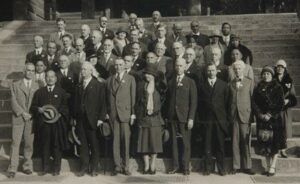
The Institute of Pacific Relations’ (IPR), formed in Honolulu, Hawaii in 1925 was one of the leading organizations convening international discussions in this era. The IPR, akin to a non-governmental precursor to today’s Asia-Pacific Economic Cooperation (APEC), offered a connection point to address common concerns and defuse tensions for societies around the rim of the Pacific Ocean. The organization was governed by ‘national councils’ made up of citizens from the United States, Japan, China, Canada, Great Britain, Australia, and New Zealand.
In 1927, even though the Japanese specifically requested that a ‘Negro of distinction’ be included at the IPR’s second conference in Honolulu, the White American hosts determined Black Americans had nothing to contribute to policy discussions involving Asia. For the 1929 conference in Kyoto, Japan the Americans weighed honoring the host’s desire for Black participation vs. creating a precedent that recognized Black Americans did have something to contribute.
Respect for the host won out and James Weldon Johnson—best known today as co-author of ‘Lift Every Voice and Sing,’ (the Black National Anthem)—was invited as the sole Black American among the total 45 U.S. delegates. Johnson’s experience as a former diplomat and his role as Secretary of the NAACP provided him familiarity with both international and U.S. domestic policy questions. Japanese media covered him prominently, presenting him as a ‘world figure’ known for commitment to ‘the emancipation of the non-white races of the world.’ People followed him like a celebrity on the streets of Tokyo and he was accorded the honor of an invitation to a garden party hosted by Emperor Hirohito.
The 1929 conference focused on the theme “the peoples of the Pacific have become the captains of their own destinies.” Certainly, a man as schooled in the political realities facing Black Americans as Johnson was, would have compelling insights on that theme.
For many Black Americans, Japan’s success in modernization was seen as a rebuke to Western imperialism’s premise that only Whites possessed capacity for self-governance and industrial development. When the IPR’s Kyoto conference was held, Japan’s military actions had not yet raised imperialist concerns that their 1931 appropriation of Manchurian territory would. In the coming decade, Japan as an object of admiration or caution, became a prism for discussion of imperialism by African American intellectuals.
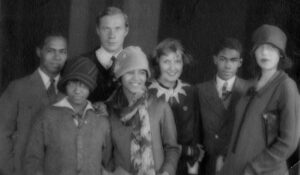
Another participant in the quest for national self-determination was Trinidad-born Percy Chen. His father, Eugene Chen, became Trinidad’s first ethnic Chinese lawyer. The senior Chen heeded Sun Yat Sen’s appeal to the Chinese diaspora to join the revolution overthrowing the imperial system in 1911. In 1912 Eugene Chen went to China, serving in various capacities, and in 1926 became Foreign Minister.
Percy, whose mother was of African and French ancestry, completed his law training in England in 1922, practiced in Trinidad, then in 1926 followed his father to China. During a period of tension with the British government representatives in Wuhan, and within the Nationalist Party itself, Percy became an aide to his father in China’s Foreign Ministry.
After the 1927 split between the more conservative and leftist wings of China’s Nationalist Party, which Eugene Chen’s side lost, Percy Chen made an epic overland escape to Russia. Eight years later in 1935, his father, retired but still influential, sent Percy on a mission to build an alliance amongst left- and right-wing Chinese to defend against Japan’s looming aggression. During the Second World War, Percy worked in Chongqing as the private secretary of Sun Fo (the son of Sun Yat Sen). In 1947, he moved to Hong Kong and successfully practiced as a barrister, maintaining his role as a connection point between the West and different Chinese political factions.
The Pentecostal movement that began at the Azusa Street Revival held at a Black-led church in Los Angeles in 1906, created the first black denomination founded in the 20th Century. Pentecostalism quickly spread around the United States and then overseas. The evangelist Edward A. Carter Sr. was an example of its international ambition. Carter, a member of the Holiness Church in Los Angeles and his Anglo-Indian wife, Mary, in 1925 moved with their three children to Calcutta to launch a mission. The Carters had great success in attracting converts, but their marriage broke down and in 1927, Carter boarded a ship with the three children, intending to return to Los Angeles. Typhoid fever forced disembarkation in Shanghai. Carter’s younger son, William, required a lengthy hospital stay, leading his elder son, Edward Jr. to ask whether God was offering a suggestion on where Carter should next work.
Carter began preaching at evangelistic meetings at the Chinese YMCA in Shanghai. His fervor attracted standing room only crowds. By 1928, he was traveling to neighboring cities and three Holiness missions had been established in Shanghai. Significantly, Carter ascribed his being Black as part of the source of his success. At a time of strong antiforeign sentiment where just a year earlier, various Westerners including a prominent White missionary, had been killed by Chinese soldiers and citizens in the Nanking Incident, Carter was welcomed to evangelize in provinces beyond the protections of Western-controlled Shanghai. Carter’s statements about this period suggest pride that his identity enabled him to serve where other Western missionaries couldn’t.
Black-led faith connections in Asia also catalyzed exchanges that would eventually shape the 1950s and 1960s Civil Rights Movement in the United States. Mahatma Gandhi’s use of nonviolence to achieve political change in India and its impact on Dr. Martin Luther King Jr. ‘s nonviolent direct actions are well known. Less familiar is the tilling of the soil that an African American couple undertook twenty years earlier, when they became the first Black Americans to meet Gandhi.
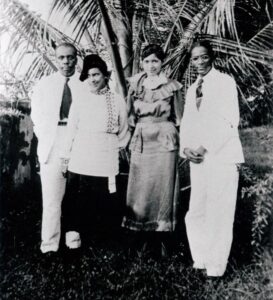
Sue Bailey Thurman and Howard Thurman were arguably the leading Black intellectual couple of the interwar period. Each of them possessed impressive achievements and both were committed to social equality in the United States. In a multi-month period between 1935 and 1936, they led the first African American delegation to India. The ‘Pilgrimage of Friendship to the East,’ enlisted participation by student Christian movements in America, India, Ceylon (now Sri Lanka), and Burma (now Myanmar). As was true in China for Edward Carter Sr., the Thurmans’ Black identity was seen positively by the people of South Asia. Keenly aware of Indians’ hostility toward white missionaries known for cooperating with colonial oppression, the Pilgrimage’s Indian organizer sought Black Americans in hopes of fostering constructive exchange.
Gandhi impressed the Thurmans deeply. Howard Thurman would spend the rest of his long ministry applying Gandhi’s teachings. In 1944, the Thurmans co-founded the first nondenominational interracial church in the United States, the Church for the Fellowship of All Peoples in San Francisco. Howard Thurman’s most famous book, Jesus and the Disinherited was published in 1949 and used the Gospels to show how a nonviolent movement could successfully achieve civil rights in America. It was the book Martin Luther King Jr. carried with him everywhere, influencing his thinking on how to approach the situation in the United States. Today, Dr. King is recognized as one of America’s giants. The seeds leading to the fruitful harvest of his profound achievements were first pollinated by the Thurmans’ 1935-36 pilgrimage to South Asia.
As part of the post-World War I critique of Western imperialism, Japan sought to present itself as a refutation of white supremacy’s claims, while cloaking its own imperial ambitions in language of pan-Asian unity. Two of America’s preeminent writers of the interwar era, W.E.B. Du Bois and Langston Hughes, spent time in, and wrote about, Asia, with differing impacts on their reputations.
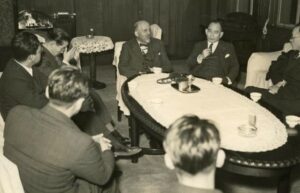
Du Bois first began writing about Japan’s rise in 1905 at the time of the Russo-Japanese War. By the early 1930’s, Japan had invaded China’s northeast province, Manchuria, and declared the formation of a separate puppet state, Manchukuo. It has also provoked a military conflict in Shanghai. Yet, Du Bois was still publicly equating Japan and China to sparring relatives engaged in a family fight. His disdain for imperialism as practiced by the West did not extend to Japan. In fact, Du Bois argued that Japan’s actions were understandable in light of what he characterized as China’s disunity and naive engagement with the West.
In 1936, Du Bois took an extended trip in Asia, marveling at the wonders of Japan-dominated Manchukuo and reveling in the welcome he was accorded in Japan. In contrast he reviled Western-dominated Shanghai which he claimed evoked a Jim Crow-esque atmosphere. His impressions of Shanghai reinforced his concerns about Western dominance and what he viewed as the placating servility of the Chinese. By contrast, experiences in Manchukuo and Japan buttressed his favorable assessments of Japan.
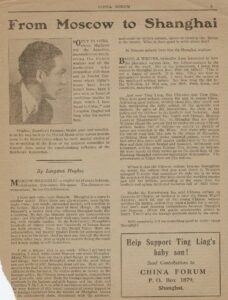
Three years earlier in 1933, Hughes arrived in Asia as part of a round-the-world trek. He, too, observed American-style segregation in aspects of how Shanghai operated, but drew from them very different conclusions, seeing the Chinese as sympathetic. In Japan, Hughes’s reception could not have been more different than that accorded Du Bois. The Tokyo police brought him in for interrogation: why had he gone to Moscow? Had he served as a courier bringing materials from the USSR? Why was he consorting with leftist Japanese writers and actors? The upshot was Hughes was ordered to refrain from further interactions with Japanese citizens, forced to leave the country, and forbidden to return.
Following Japan’s invasion of China in 1937 with widespread reports of civilian atrocities, Du Bois was still defending Japan. By contrast, Hughes penned a pro-China anti-colonial poem ‘Roar, China!’ Both writers influenced American discussion of Japan and China, but one’s analysis has held up better over the decades than the other. When in the early 1960s Du Bois visited China under Mao, he finally repudiated his earlier assessments.
Even when faced with considerable constraints at home, during the interwar period African Americans engaged in Asia across a range of fields. The best known among them is in the performing arts, but as these examples show, African Americans were also making contributions in international relations, faith, and writing/journalism. Additionally, in the performing arts domain, the scope of participation by Black artists in Asia was often more impactful than is commonly recognized: either by virtue of the effect these performers’ artistry had on Asian creators and consumers of popular culture, or as a jumping off point for the artists’ other interests (such as by honing new aspects of artistic talent or exploring business opportunities).
Japan’s 1937 invasion of China, followed by its attack on Pearl Harbor in 1941, would put an end to this interlude. But, as this brief essay shows, there is fertile material to be mined, whether as to on-screen depictions of glamorous African American bands and stage performers entrancing a swirling international crowd in a pristine Art Deco Shanghai ballroom, or through nonfiction research deepening public awareness of intrepid talents beyond those touched upon here. To paraphrase Hughes, ‘Black Americans Roared!’ in Asia, and their fascinating experiences and accomplishments deserve wider recognition.

